For years, marketers have relied heavily on third-party cookies to monitor user behaviors and optimize targeting. However, shifts in data privacy laws (like GDPR and CCPA), the increased use of ad-blockers, and heightened consumer awareness around privacy concerns have significantly changed the landscape. Dependence on third-party data is increasingly untenable.
As a result, marketers are turning their attention to first-party data. Let’s take a look at what first-party data is, and some of the leading first-party data collection tools that every marketer needs in their toolbox.
What is First-Party Data, and Why Is It Important?
First party data is information you collect directly from your audience—through your website, app, emails, surveys, and more. It’s accurate, consent-driven, and privacy-friendly. And most importantly, it’s yours.
As privacy regulations become stricter and consumer awareness grows, first-party data is becoming increasingly valuable. By focusing on collecting and leveraging first-party data, businesses can build direct relationships with their customers, deliver personalized experiences, and maintain compliance with data privacy laws.
First-party data is also essential because major browsers like Chrome and Safari are phasing out third-party cookies. As we navigate deeper into this post-cookie world, first-party data isn’t just a compliance measure. It’s essential for delivering personalized experiences and achieving successful marketing outcomes. Collecting quality data directly from consumers is now a strategic necessity, offering brands reliable insights and competitive advantages.
How Does First-Party Data Differ from Second- and Third-Party Data?
As we mentioned, first-party data is the data you collect directly from your audience. It’s gathered through various touchpoints and interactions, including website visits, social media engagement, email signups, online transactions, customer surveys, and CRM systems. This data provides valuable insights into customer behavior, preferences, and demographics, allowing for personalized marketing and improved customer experiences.
Second-party data is data that comes from another organization’s first-party data and is shared with you through a partnership. This collaboration can be mutually beneficial, allowing both parties to expand their reach, target new audiences, and gain valuable insights. Second-party data can be obtained through co-marketing campaigns, data-sharing agreements, or joint ventures.Third-party data is data that’s collected and aggregated by external sources. It’s often purchased from data brokers or aggregators and can include demographic information, browsing behavior, and purchase history. While third-party data can be useful for reaching a broader audience, it often lacks transparency and consent, raising concerns about privacy and accuracy.

Key Benefits of First-Party Data
- Accuracy and Reliability: Since first-party data is collected directly from your audience, it tends to be more accurate and reliable than second- or third-party data.
- Relevance and Personalization: First-party data provides insights into your specific audience, allowing for targeted and personalized marketing campaigns.
- Compliance and Control: By collecting and managing first-party data yourself, you have greater control over data privacy and compliance with regulations.
- Customer Trust: Transparent data collection practices and respect for customer privacy can build trust and loyalty.

Our Top 10 First-Party Data Collection Tools
Now that you understand how important first-party data is, here are some tools you can start using to collect first-party data and level up your game!
1. HubSpot Forms

Best for: Lead capture and CRM integration
Hubspot offers fully customizable forms that integrate directly with its CRM platform. You can collect emails, preferences, and behavior insights while syncing them effortlessly to customer profiles.
One of the major pros of using HubSpot Forms is its integration with other HubSpot tools, which allows you to seamlessly incorporate lead capture forms into your broader marketing strategy.
The tool also offers the ability to track and analyze form submissions, providing valuable insights into the performance of the forms. However, there are also some potential cons to using HubSpot Forms, such as its limited design options and the potential for a steep learning curve for new users.
Overall, HubSpot Forms is a useful tool for marketers looking to integrate their lead capture efforts with their broader marketing strategy.
2. Twilio Segment

Best for: Customer data infrastructure
Segment is less of a point solution and more of a foundational layer. By allowing businesses to collect, unify, and direct customer data from multiple touch points, Segment supports a truly integrated first-party data strategy.
Its biggest strength lies in helping organizations move away from fragmented data silos, which is an issue that often comes in from duplicated effort and incomplete customer understanding. With Segment, every event (from email clicks to app usage) can be tracked and standardized. This ensures that your marketing and product teams operate from a single source of truth. It will not only improve targeting but empower teams to make live decisions grounded in reliable data.
3. Typeform
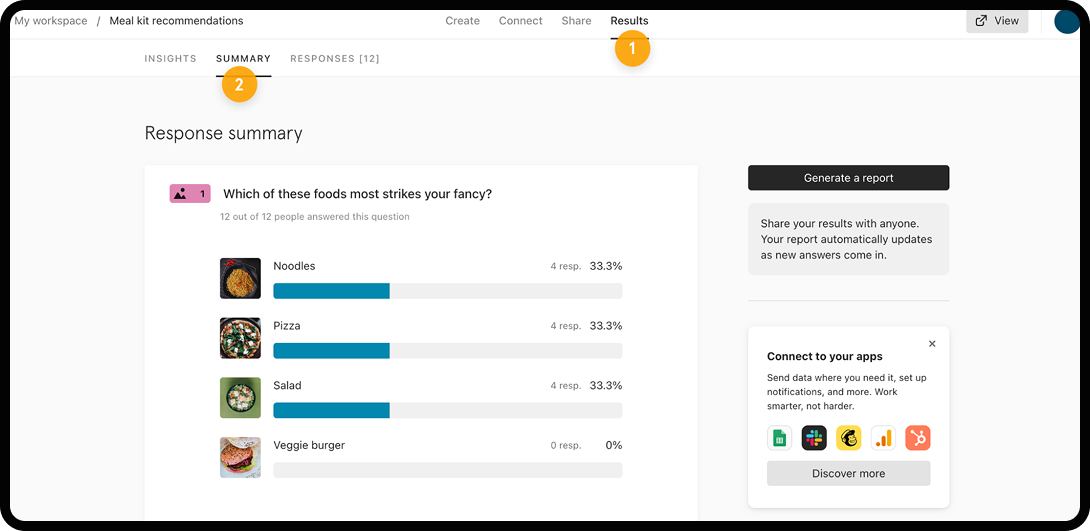
Best for: Interactive surveys and feedback
Typeform transforms the often-tedious process of data collection into an engaging dialogue. Its minimalist, single-question display keeps the attention and engagement of respondents high, significantly boosting completion rates and making it an excellent choice for brands seeking in-depth audience understanding without causing survey fatigue.
Whether the goal is to establish a continuous feedback mechanism, create interactive product quizzes, or gather specific user preferences, Typeform provides invaluable insights directly from the source. This user-provided data offers a depth of understanding unattainable through indirect means.
The platform fosters a sense of personal interaction, which is crucial in eliciting honest and detailed responses, ultimately yielding more meaningful and actionable first-party data for marketing strategies.
4. Google Analytics 4 (GA4)

Best for: Behavioral tracking across channels
Google Analytics 4 is a major step forward in understanding how users interact with your site. By shifting to an event-based model, it tracks specific actions rather than just pageviews. This gives a clearer picture of where users engage, how long they stay, where they drop off, and how to improve their experience.
For marketers, GA4 makes it easier to see which campaigns are actually driving results. You can go beyond general traffic numbers and pinpoint what is working across different channels, helping you make smarter decisions with your budget.
With the decline of third-party cookies, GA4’s emphasis on first-party data is especially important. It allows you to stay in control of your data while keeping up with evolving privacy standards and user expectations.
While there is a learning curve, the insight you gain makes the effort worth it. GA4 helps you understand your audience more clearly, tailor experiences more effectively, and stay competitive in a privacy-conscious, data-driven world.
5. Qualtrics
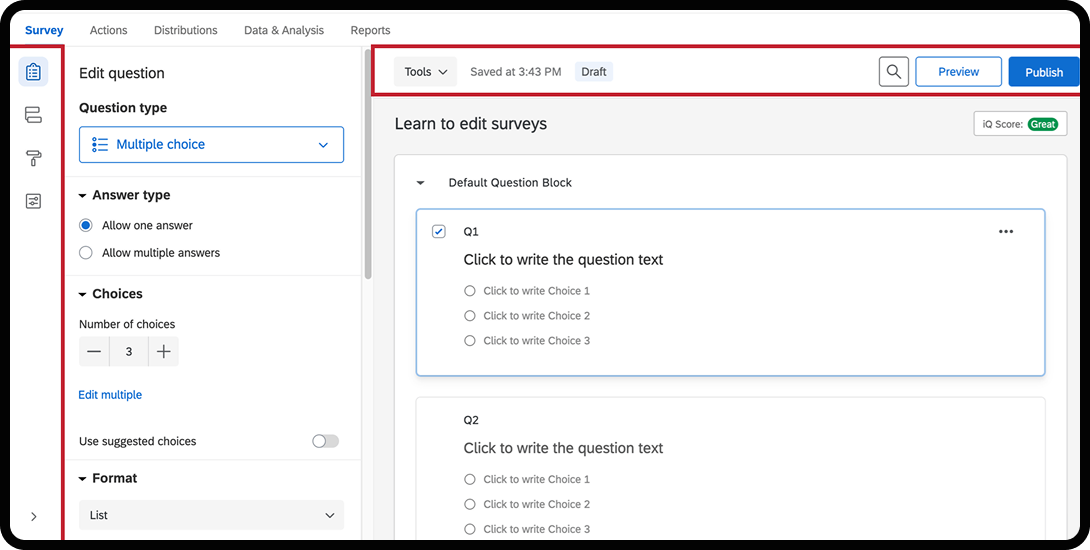
Best for: Experience management and structured insights
Qualtrics goes beyond basic survey tools by helping you actually understand what your audience is thinking and why it matters. While it can handle large-scale feedback efforts, its real strength lies in how it helps you interpret information and use it to guide meaningful decisions. Rather than just giving you numbers, Qualtrics helps uncover the story behind the data.
Whether you are measuring customer satisfaction through NPS surveys, exploring brand perception, or gathering day-to-day feedback, the platform provides the tools to capture and analyze insights with purpose. It is especially valuable for teams that truly want to listen to their audience and use that feedback to improve products, shape messaging, or refine their overall strategy.
By turning raw input into usable insight, Qualtrics makes it easier to align your work with what customers actually want. That clarity leads to better decisions, stronger relationships, and ultimately, more impactful results.
6. Hotjar

Best for: Visual behavior insights
Understanding user behavior requires more than just numbers. Visual insights play a key role in revealing how people actually interact with your site. Hotjar offers tools like heatmaps that highlight where users click, scroll, and hover, helping you spot both areas of engagement and points of friction. Session recordings go a step further by capturing individual user journeys in real time, giving you a front-row seat to how people navigate, hesitate, or drop off.
This kind of visual context bridges the gap between quantitative metrics and user experience design. A high bounce rate, for instance, might make more sense when you can see that a call-to-action is buried or that a form is more complicated than expected. Hotjar turns guesswork into evidence, making it easier to optimize your site with intention. The result is a smoother experience for your users, smarter design choices for your team, and stronger conversion outcomes overall.
7. Mailchimp
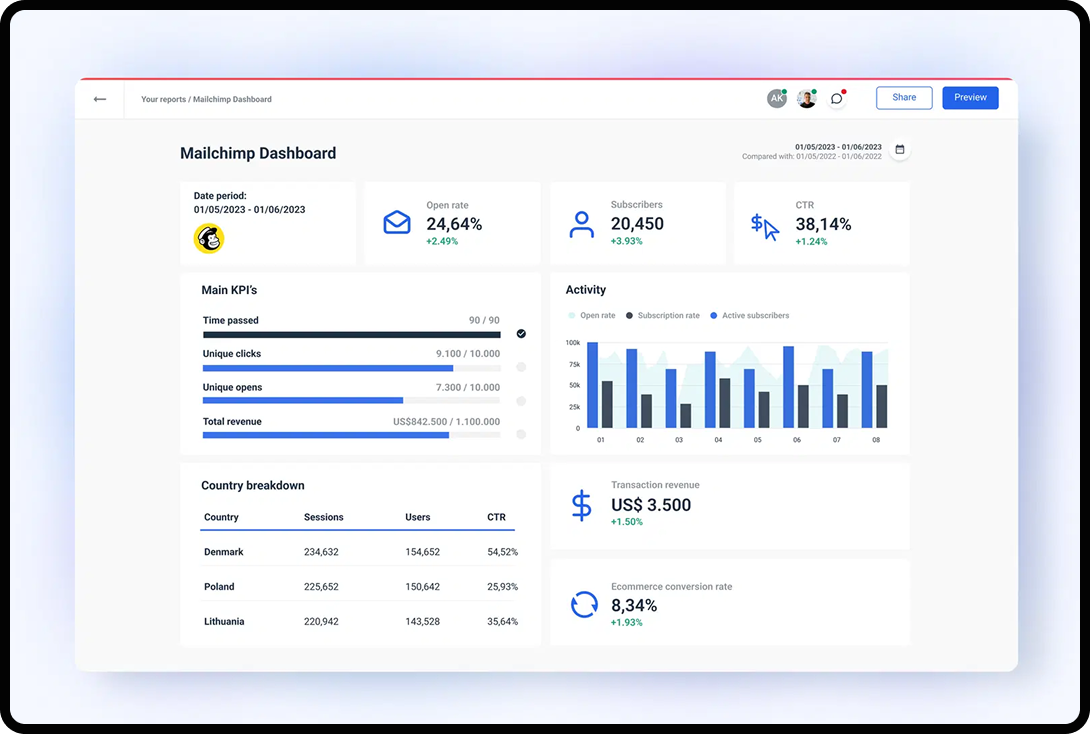
Best for: Email marketing and lead segmentation
Mailchimp has come a long way since its inception. It’s no longer just a way to send out newsletters—it’s a full email marketing tool with smart automation, segmentation, and real-time feedback. You can see how users interact with your emails, what they click, and when they drop off—and then use that data to send better, more relevant messages.
You can build signup forms, customize preferences, and trigger flows based on behavior. It’s a first-party data tool that meets people where they already are: their inbox. For small to mid-size teams, it’s an accessible way to turn engagement into insight.
8. Jebbit

Best for: Zero- and first-party data via quizzes
Jebbit transforms first-party data collection into something that feels both valuable and enjoyable for the user. Instead of relying on traditional or overly intrusive methods, it gives marketers a suite of interactive formats designed to encourage real participation. Product match finders guide users toward the right items through personalized questions. Interactive lookbooks invite people to browse visually and intuitively. Quizzes keep users engaged while surfacing meaningful insights in the background.
This type of experience works particularly well for brands in beauty, fashion, and eCommerce, where tailored content can directly influence buying decisions and brand perception. Jebbit enables companies in these spaces to offer personalization in a way that feels natural and noninvasive. When users are given something engaging or genuinely useful in return, they are far more likely to share their preferences willingly.
Since every interaction is opt-in, the information collected is not only more trustworthy but also more relevant to what users actually want. These inputs provide a clear window into individual preferences and expectations. Rather than gathering passive data points, brands gain access to insight that can be applied across campaigns, product recommendations, and creative direction. With Jebbit, you are creating opportunities to better understand your audience and build longer-lasting, more authentic relationships.
9. OneTrust Preference Center
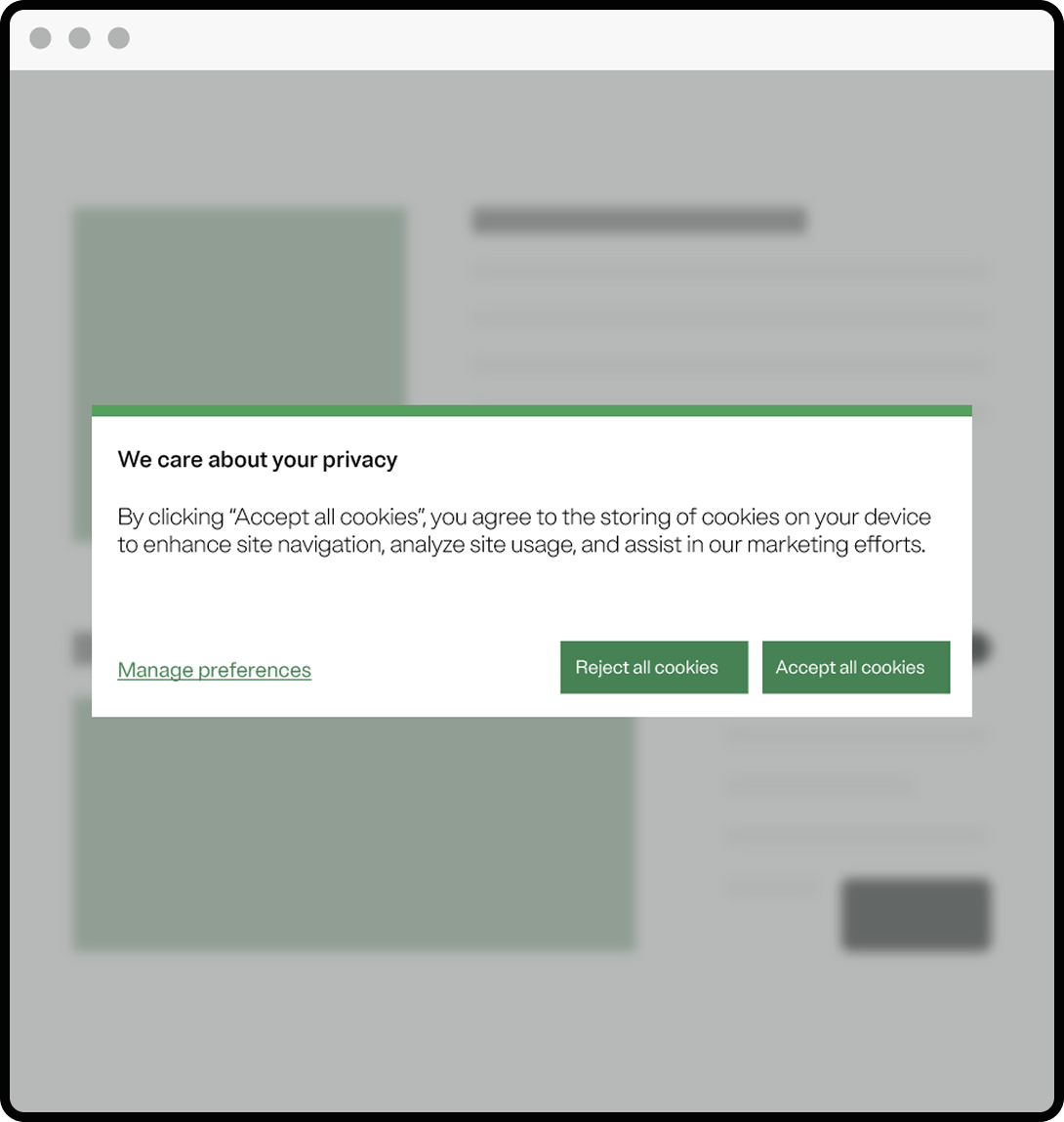
Best for: Consent and preference management
As privacy expectations rise, giving users control over their data is no longer optional—it is expected. OneTrust’s Preference Center makes that control easy to manage on both sides. It allows users to set their communication preferences, choose what types of data they want to share, and adjust settings whenever they need to.
For marketers, this means cleaner, more reliable data and a stronger foundation for building trust. It also helps ensure compliance with global privacy regulations, which continues to be a priority as laws evolve. Instead of treating consent as a one-time checkbox, OneTrust helps turn it into an ongoing, transparent process.
By empowering users to make choices about how they interact with your brand, you’re showing that you respect their privacy. In return, they’re more likely to stay engaged. The result is a better customer experience and a stronger relationship built on clarity, choice, and mutual respect.
10. Shopify Customer Accounts
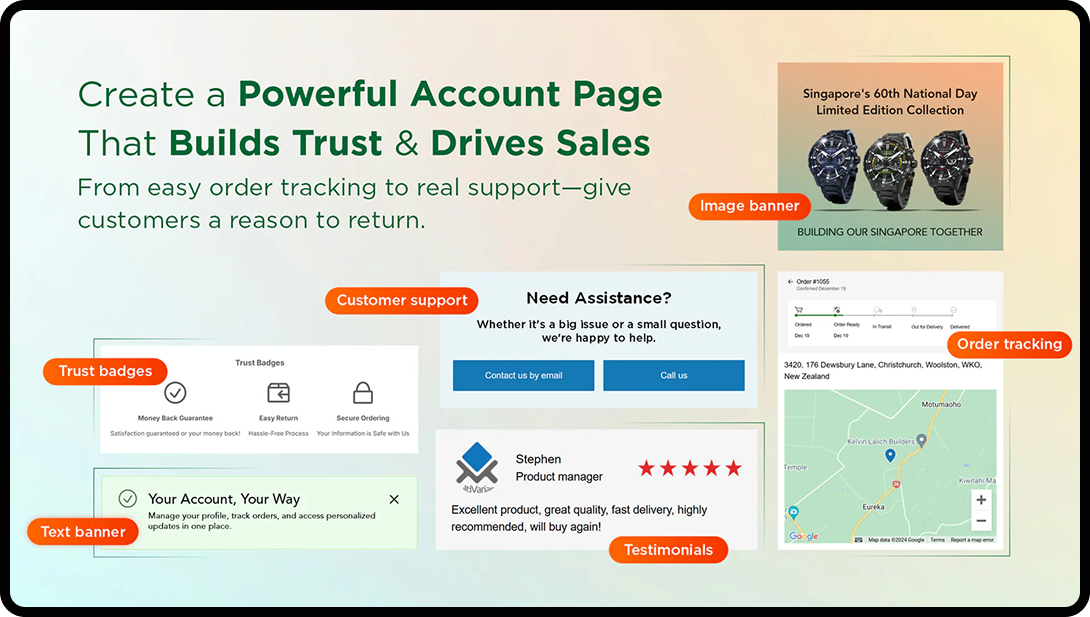
Best for: eCommerce customer insights
If you’re running your eCommerce brand on Shopify, your customer accounts hold some of the most valuable and often underutilized first-party data available. Every product viewed, purchase made, or item saved to a wishlist contributes to a real-time behavioral profile that exists natively within the platform.
This data isn’t abstract. It’s tied directly to intent and decision-making. You can use it to trigger highly personalized retargeting campaigns, send timely restock alerts, offer tailored promotions, or build loyalty flows that reflect each customer’s shopping habits. Since it all happens within your owned ecosystem, there’s no need for guesswork or manual integration—just a clear view into who your customers are and how they interact with your store.
For brands focused on long-term customer value and retention, activating these insights isn’t just helpful. It’s a strategic advantage hiding in plain sight.
Ready to Leverage First-Party Data for Your Growth?
As privacy regulations tighten and user expectations for personalized experiences grow, the ability to collect and activate first-party data has become a defining feature for modern marketers. The tools outlined in this guide offer comprehensive solutions for capturing customer insights directly through brand-owned channels, ensuring transparency, regulatory compliance, and a deeper understanding of audience behavior.
By embedding these platforms into your day to day data strategy, your team will be choosing a path that prioritizes transparency, relevance, and long-term connection. In an industry that is defined by rapid change and rising expectations, integrating first-party data into your strategy will strengthen consumer trust and create a foundation for scalable growth and long-term competitive advantage.






